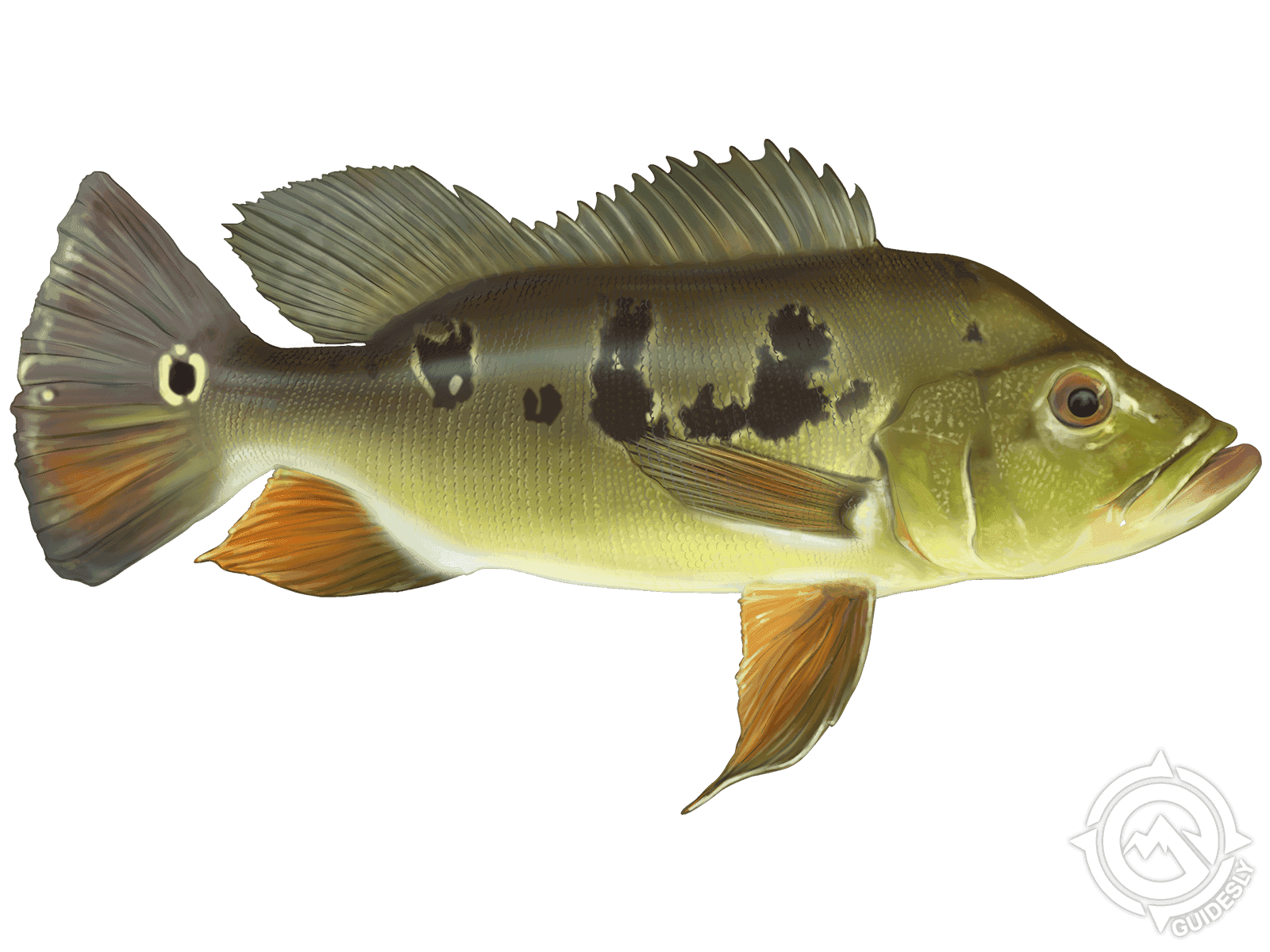Peacock Bass

Species Details
Cichla Ocellaris
Cichlidae
Perciformes
River, Lake, Canal
3 - 15 lbs.
10" - 29"
Peacock Bass (Cichla Ocellaris) Description
The Peacock Bass has a slanting forehead with an elongated body and a large mouth with a protruding lower jaw. Its body and fins are a mix of yellows, greens, light red, and orange and will vary with each individual. Normally, they're olive-green on the back gradually fading to a yellow-orange or even white towards the underside.
The common characteristic this fish will share is three vertical black lines along its sides, which fade as it matures. They may have several dark splotches on their sides, and larger adults may have a yellow-orange stripe from their snout to the base of the tail. They have a black spot or ocellus with a yellow or silver border on their rounded caudal fin which resembles a peacock’s feathers.
The Peacock Bass is not related to any other bass and is only similar in size and shape to the American largemouth bass.
Diet and Size
The Peacock Bass grows fast and can reach an average length of 12-14 inches in less than 2 years. The largest unofficial record of this fish is 35 inches.
The Peacock Bass is predatory and will feed on almost any other fish, but prefers tilapia, oscar, crayfish, tadpoles, mosquitofish, minnows, and guppies.
Its speed and large mouth lead them to be successful hunters. They feed during the day. Ideally, it can add up to 1.5 pounds in weight for every extra inch it grows. This fish typically lives up to 6-10 years of age.
Interesting Facts
- It was introduced to Florida in 1984 to manage the populations of tilapia and oscar from northeastern South America.
- A majority of adults grow a prominent nuchal hump on their foreheads
- Physical characteristics vary depending on their location
- Its colors intensify during spawning seasons
- It is known as a “freshwater bully” because of its aggressiveness
Spawning
The Peacock Bass spawns between April to September, with a peak in May and June. Adults will create a spawn location near the shore, usually a hardened flat surface for the eggs to be laid. Both parents will protect the young from predators and will move the larvae with their mouths to shallow depressions in sediment or rocky structures.
Habitat & Distribution

This freshwater fish prefers warmer waters with slower currents such as lakes, ponds, creeks, and
canals. Shaded areas under trees and bridges are also favorite habitats. It cannot survive in waters with high or in temperatures below 60 degrees.
You will basically only find these fish in Florida and the farther south you go, the better. The Peacock Bass is found in Florida and they are abundant in the 330 miles of canals in Dade, Broward, and Palm Beach counties.
Fishing Techniques - How to Catch a Peacock Bass
They are caught by anglers casting from the shoreline, trolling, or still fishing.
Fishing for Peacock Bass uses the same techniques you would use for largemouth bass, except it doesn’t like plastic worms. Light spinning and bait-casting tackle with a 12-15lb test is a common rig to use.
One way to catch their attention is using live golden shiners, aptly nicknamed “peacock shiners” because of their effectiveness, but some anglers prefer casting lures. Using topwater jigs, spoons or crankbaits have proved to be effective. If fly fishing is preferred, go with large streamers such as marabou.
Rocky, shaded areas such as bridges, and spots with aquatic plants, fallen trees, canal ends, and intersections are preferred habitats of this fish. Daylight is the best time to catch this fish when they are out hunting and larger individuals are caught during peak seasons in March to June and September to December.







